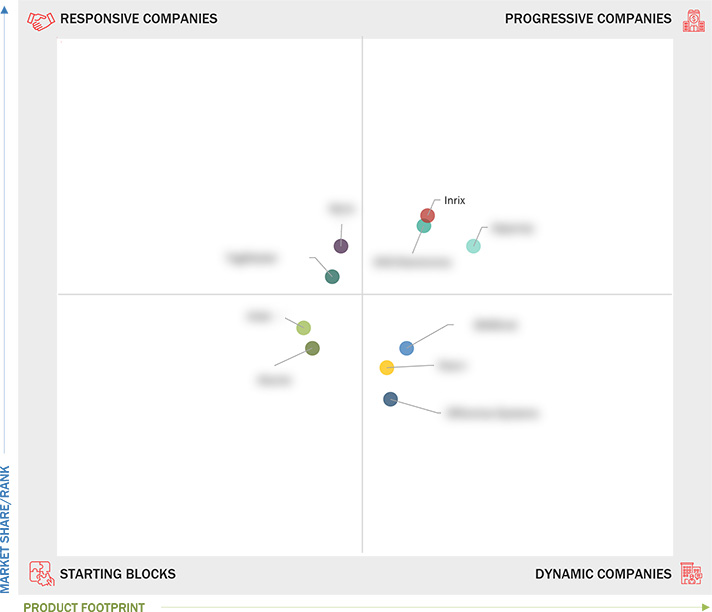Comparing 10 vendors in Smart Transportation Startups across 0 criteria.
✔️ What You Get with This Report
- 📊
Comprehensive Company Analysis - Business strategy, SWOT, financials, growth areas, M&A moves
- 🏆
Market Position & Share Insights - Visual competitive landscape (like the quadrant above)
- 🔍
Segment-level Benchmarking - Product, region, and end-user vertical
- 📁
Image & Report PDF Downloads - Ready-to-use for presentations and strategy sessions
- 📈
Demand Generation [Optional Buy] - License quadrant to drive demand & showcase leadership
✔️ Analyst-led
✔️ One-time payment
👉 Get Instant Access
The Smart Transportation market is at the forefront of integrating cutting-edge technological advancements to enhance global transportation systems' efficiency, safety, and sustainability. This market has grown enormously due to adopting IoT, AI, big data analytics, and cloud computing technologies. These technologies are instrumental in transforming traditional transportation methods into smart mobility solutions that address the growing demands of urbanization, environmental sustainability, and efficient transport systems. Governments worldwide are increasingly investing in public-private partnerships (PPP) models to modernize their transport infrastructure, aiming to provide seamless and safe transit options to the burgeoning urban populations. The report comprehensively analyzes market dynamics, competitive landscapes, and company evaluations, identifying key trends and future growth opportunities. The focus on smart city initiatives and the deployment of innovative solutions in smart transportation are critical steps toward addressing congestion and promoting smart, connected cities. As such, this transformative market is pivotal in driving economic growth and improving citizens' quality of life through enhanced transportation methodologies.
Startups in the Market
BASSnet: Based in Norway, BASSnet is a dynamic player in the smart transportation space. It leverages private solutions to enhance maritime transport efficiency.
EKE-Electronics: Operating from Finland, this progressive company specializes in providing electronic systems to enhance railway transportation. It is backed by private equity investments.
Iteris: A privately held startup in Austin, US, Iteris focuses on intelligent traffic management and data solutions, benefiting from private equity and grant funding.
Inrix: This US-based startup offers innovative traffic and parking data solutions, supporting urban planning with significant institutional investment funds.
Park+: An emerging player from India, Park+ is revolutionizing parking management and urban mobility, supported by a series of private equity investments.
1 INTRODUCTION 1.1 Study Objectives 1.2 Market Definition 1.3 Study Scope 1.3.1 Market Segmentation 1.3.2 Inclusion and Exclusion 1.3.3 Years Considered 1.4 Currency Considered 1.5 Stakeholders 1.6 Summary of Changes 2 MARKET OVERVIEW AND INDUSTRY TRENDS 2.1 Introduction 2.2 Market Dynamics 2.2.1 Drivers 2.2.1.1 Increasing demand for autonomous and connected vehicles 2.2.1.2 Technological advancements to enhance customer experience 2.2.1.3 Growing government initiatives and PPP models for smart transportation 2.2.1.4 Rising urban population and high demographic rates 2.2.2 Restraints 2.2.2.1 Integration challenges for new age and legacy systems 2.2.2.2 Lack of standardized and uniform technology 2.2.2.3 Stringent transportation regulatory policies 2.2.3 Opportunities 2.2.3.1 Leveraging smart city initiatives for growth in smart transportation 2.2.3.2 Designing and developing connected vehicles compatible with ITS 2.2.3.3 Penetration of analytics in smart transportation 2.2.3.4 Decline in vehicle ownership with advancement of MaaS 2.2.4 Challenges 2.2.4.1 Scalability of smart transportation solutions in large cities 2.2.4.2 High initial cost of deployment 2.2.4.3 Multiple sensors and touchpoints posing data fusion challenges 2.3 Evolution of Smart Transportation 2.4 Ecosystem 2.5 Market Segmentation Overview 2.6 Value Chain Analysis 2.7 Market Sizing Assumptions and Forecast Methodology 2.8 Regulatory Landscape 2.9 Technology Analysis 2.9.1 Key Technologies 2.9.1.1 Vehicle-to-Everything (V2X) 2.9.1.2 AI & ML 2.9.1.3 Autonomous Vehicles 2.9.1.4 GIS 2.9.2 Complementary Technologies 2.9.2.1 5G/6G Connectivity 2.9.2.2 Digital twin 2.9.2.3 ADAS 2.9.2.4 Blockchain 2.9.3 Adjacent Technologies 2.9.3.1 Augmented Reality (AR) 2.9.3.2 Smart sensors & cameras 2.9.3.3 Robotics 2.10 Patent Analysis 2.10.1 Methodology 2.10.1.1 List of major patents 2.11 Trade Analysis 2.11.1 Export Scenario of Electrical Signalling, Safety, or Traffic Control Equipment 2.11.2 Import Scenario of Electrical Signalling, Safety, or Traffic Control Equipment 2.12 Porter’s Five Forces Analysis 2.12.1 Threat of New Entrants 2.12.2 Threat of Substitutes 2.12.3 Bargaining Power of Buyers 2.12.4 Bargaining Power of Suppliers 2.12.5 Intensity of Competitive Rivalry 2.13 Trends/Disruptions Impacting Customer Business 2.14 Strategic Initiatives by Governments and Key Players 2.15 Key Conferences and Events, 2025–2026 2.16 Technology Roadmap for Smart Transportation 2.16.1 Smart Transportation Technology Roadmap Till 2030 2.16.1.1 Short-term roadmap (2025–2027) 2.16.1.2 Mid-term roadmap (2027–2029) 2.16.1.3 Long-term roadmap (2029–2031) 2.17 Impact of AI/Generative AI on Smart Transportation Market 2.17.1 Use Cases of Generative Smart Transportation 2.18 Investment & Funding Scenario 3 COMPETITIVE LANDSCAPE 3.1 Introduction 3.2 Key Player Strategies/Right to Win 3.3 Revenue Analysis 3.4 Market Share Analysis 3.5 Market Ranking Analysis 3.6 Product Benchmarking and Comparison 3.7 Company Evaluation Matrix: Start-Ups/SMEs, 2024 3.7.1 Progressive Companies 3.7.2 Responsive Companies 3.7.3 Dynamic Companies 3.7.4 Starting Blocks 3.7.5 Competitive Benchmarking: Start-Ups/SMEs, 2024 3.7.5.1 Detailed list of key start-ups/SMEs 3.7.5.2 Competitive benchmarking of key start-ups/SMEs 3.8 Competitive Scenarios & Trends 3.8.1 Product Launches 3.8.2 Deals 3.9 Brand/Product Comparison 3.10 Company Valuation and Financial Metrics of Key Smart Transportation Market Providers 4 COMPANY PROFILES 4.1 BASSNET 4.1.1 Business overview 4.1.2 Products/Solutions/Services offered 4.1.3 Recent developments 4.2 EKE-ELECTRONICS 4.2.1 Business overview 4.2.2 Products/Solutions/Services offered 4.2.3 Recent developments 4.3 AITEK 4.3.1 Business overview 4.3.2 Products/Solutions/Services offered 4.3.3 Recent developments 4.4 ITERIS 4.4.1 Business overview 4.4.2 Products/Solutions/Services offered 4.4.3 Recent developments 4.5 INRIX 4.5.1 Business overview 4.5.2 Products/Solutions/Services offered 4.5.3 Recent developments 4.6 TAGMASTER 4.6.1 Business overview 4.6.2 Products/Solutions/Services offered 4.6.3 Recent developments 4.7 ATSUKÈ 4.7.1 Business overview 4.7.2 Products/Solutions/Services offered 4.7.3 Recent developments 4.8 PARK+ 4.8.1 Business overview 4.8.2 Products/Solutions/Services offered 4.8.3 Recent developments 4.9 APPYWAY 4.9.1 Business overview 4.9.2 Products/Solutions/Services offered 4.9.3 Recent developments 4.10 EFFTRONICS SYSTEMS 4.10.1 Business overview 4.10.2 Products/Solutions/Services offered 4.10.3 Recent developments
Latest
Cities Climate Action Summit 2024 – meet the exhibitor: AppyWay
 Jun 2024
Jun 2024 SmartCitiesWorld
SmartCitiesWorldAppyWay to close latest investment cycle on Crowdcube
 Mar 2024
Mar 2024 SmartCitiesWorld
SmartCitiesWorldAppyWay and Connected Kerb to revolutionise EV charging and ...
 Oct 2023
Oct 2023 Fleet World
Fleet WorldIntel And INRIX Collaborate On Smart Cities Platforms And Applications Powered By Big Data
 Jul 2024
Jul 2024 Global Print Monitor
Global Print MonitorCompany List



